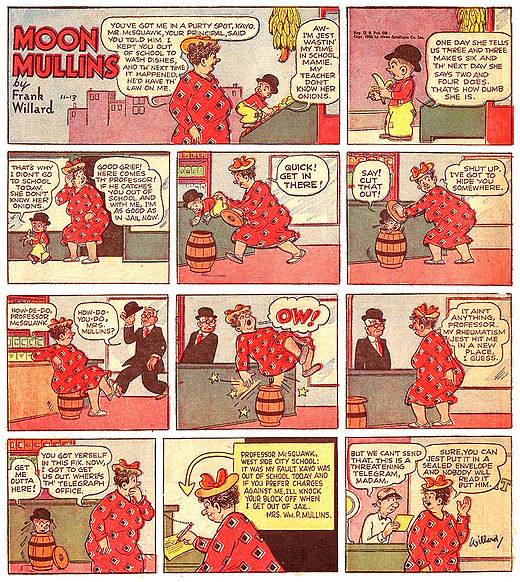- Comics artist
-
 Frank Willard's Moon Mullins (November 12, 1955) during the period it was drawn uncredited by Ferd Johnson
Frank Willard's Moon Mullins (November 12, 1955) during the period it was drawn uncredited by Ferd Johnson
A comics artist is an artist working within the comics medium on comic strips, comic books or graphic novels. The term may refer to any number of artists who contribute to produce a work in the comics form, from those who oversee all aspects of the work to those who contribute only a part.
Contents
Comic strips
Within the comic strip format, it is typical for one creator to produce the whole strip. However, it is also not uncommon for the writing of the strip and the drawing of the art to be carried out by two different people, a writer and an artist (with or without additional assistant artists). In some cases, one artist might draw key figures while another does only backgrounds.
Many strips were the work of two people although only one signature was displayed. Shortly after Frank Willard began Moon Mullins in 1923, he hired Ferd Johnson as his assistant. For decades, Johnson received no credit. Willard and Johnson traveled about Florida, Maine, Los Angeles and Mexico, drawing the strip while living in hotels, apartments and farmhouses. At its peak of popularity during the 1940s and 1950s, the strip ran in 350 newspapers. According to Johnson, he had been doing the strip solo for at least a decade before Willard's death in 1958: "They put my name on it then. I had been doing it about 10 years before that because Willard had heart attacks and strokes and all that stuff. The minute my name went on that thing and his name went off, 25 papers dropped the strip. That shows you that, although I had been doing it ten years, the name means a lot."[1]
Comic books
With regards to the comic book format, the work can be split in many different ways. The writing and the creation of the art can be split between two people, an example being From Hell, which was written by Alan Moore and drawn by Eddie Campbell. The writing of a comic book story can sometimes be shared between two people, with one person writing the plot and another the script.
The artistic work is often subdivided, especially on work produced for the larger comic book publishers, with four people typically working on the art: a penciller, an inker, a colorist and a letterer. Sometimes this combination of four artists is augmented by a fifth, a breakdown artist. However, this generally occurs only when an artist fails to meet a deadline or when a writer, sometimes referred to as a scripter, produces breakdown art. Breakdown art is where the story has been laid out very roughly in pencils to indicate panel layouts and character positions within panels but with no details. Such roughs are sometimes referred to as "layouts."
The norm of four artists is sometimes reduced to three if the penciller also inks his own work, usually being credited within the book as a penciller/inker. John Byrne and Walt Simonson are artists who have, on occasion, inked their own work.
It is worth noting that these roles are highly interchangeable, and many artists can fulfill different roles. Stan Sakai is a highly regarded letterer of comic books who also creates his own series, Usagi Yojimbo. Producing his autobiographical works, Eddie Campbell has created both scripts and art, plus teaming with his daughter on the coloring. On Cerebus, for the majority of the run, Dave Sim created everything except the backgrounds, which were drawn by Gerhard.
See also
References
External links
Categories:- Comics artists
Wikimedia Foundation. 2010.
